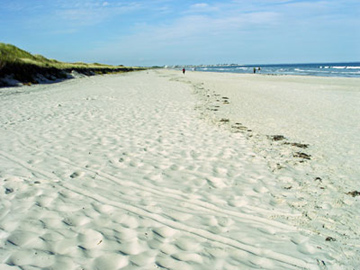The sand that squishes between your toes or works its way into uncomfortable places in your swimsuit is a little different for every beach. That’s because it comes from different sources — everything from coral reefs to mountain ranges.
 Sand comes from different sources ñ everything from coral reefs to mountain ranges. Credit: Maine Department of Agriculture, Conservation, and Forestry
Sand comes from different sources ñ everything from coral reefs to mountain ranges. Credit: Maine Department of Agriculture, Conservation, and ForestryThe sand on most mainland beaches comes from mountains and hills. The constant action of wind and rain and the cycle of freezing and thawing chips off pieces of rock. The smaller bits are washed into rivers and creeks, where they’re further broken up as they smash into each other or into the bottom. These grains eventually make their way to the sea, where the waves push them ashore, forming sandy beaches. New sand grains tend to be rough and angular, while those that have been around awhile have been worn to a rounder shape.
Most of the grains on these beaches are made of quartz, a sturdy mineral that’s clear or white. But they can be mixed with bits of darker rock and minerals, making the beach look tan.
On tropical islands, the sand grains are made of bits of shell or coral. Pounding waves grind up coral reefs that are close to shore. And fish nibble at organisms growing on the coral. They digest the edible parts, and excrete the bits of coral skeleton.
On some beaches, the sand is black, because it’s made of bits of dark volcanic rock. If the rock is rich in the mineral olivine, the sand can be dark green. And in Bermuda, a high concentration of the shells of a small organism gives the beaches a pink hue — making a day at the beach especially colorful.
This episode of Science and the Sea was made possible by Texas Sea Grant.

